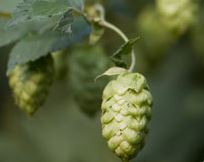The Hop Growers of America has released its hop acreage report for 2016, and the state of the American hops industry is strong.
 In 2014, U.S. hops acreage grew 10.2%; in 2015, 15.4%. And this year, hop acreage was up by 18.5%, with 53,213 total acres planted, the most since 1915.
In 2014, U.S. hops acreage grew 10.2%; in 2015, 15.4%. And this year, hop acreage was up by 18.5%, with 53,213 total acres planted, the most since 1915.
The Pacific northwest — Washington state, Oregon, and Idaho, in that order— which accounts for over 96% of all hops in the nation, planted 7,482 more hop-acres this year, an increase of 17% over 2015. Its 51,115 total acres represent a new record for the region.
The international hop broker, Barth-Haas Group also has just released its Hop Market and Crop Development Report for 2016. The data show that the United States is now the largest hop producer in the world. (Barth-Haas' acreage numbers are a bit smaller than HGA's. They show 48,933 acres for the U.S., up 16.7% over 2015.) Total high alpha hop plantings decreased 6.6% in the U.S., while aroma hop plantings acreage increased 26.1%, according to Barth-Haas.
The tense supply situation in the flavour/aroma segment should ease thanks to the considerable new acreage that has been planted for 2016 along with the maturing yields of prior years’ expansions. While the craft beer growth seems to slow down[emphasis mine] from double digits to single digits in the US in 2016 we continue to see lots of interest and growth in craft markets outside of the US. The supply of the high alpha segment has, on the other hand, become noticeably tighter over the course of the last 12 to 18 months as acreage reductions in the US have been and are being felt in the market.
Other statistics of note from the Hop Growers of America report:
- Washington’s Yakima Valley leads U.S. production with 37,475 acres, representing over 70% of the country’s acreage.
- Oregon and Idaho follow with 7,669 (15% of total U.S. acreage) and 5,971 acres (12%), respectively.
- 70% of the new acreage in the Pacific northwest is of high demand proprietary varieties.
- Cascade continues to be the most-planted hop, at 7,371 acres; Centennial, at 5,009 acres, has surpassed CTZ for second place with 5,009 acres. (Mosaic hops increased by the highest percentage, at 51.1%, to 2,717 acres planted, according to Barth-Haas.)
- A list of hop-variety acreage in the U.S. 2016 (excluding that grown outside of the Pacific northwest): here.
- 1. Michigan planted the most hops outside of the Pacific northwest, at 650 acres, an increase of more than 103%.
- 2. Then New York, at 300 acres, a 200% increase over 2015.
- 3. Wisconsin, next, with a virtual tie, at 297 acres, up nearly 75%.
- 4. Colorado has 200 acres under hop cultivation, an increase this year of 60%.
- 5. Next up is California, with 130 acres, up nearly 60% over last year.
- 6. Minnesota has 73 acres planted, over 180% more than in 2015.
- 7. Ohio is just behind, at 70 acres, representing a 40% increase.
- 8. Indiana farmers have planted 50 acres of hops this year, also 40% more than last year.
- 9. Iowa is at 40 acres, up 33.33% over 2015.
- 10. Tied at 10th for most hops planted (other than in the Pacific northwest) are Illinois, North Carolina, and Virginia, all at 30 acres.
The neighboring states of North Carolina and Pennsylvania have, respectively, 30 acres (but down from 40 acres in 2015) and 15 acres (up from 5.5) under cultivation.
YFGF's new home of the Deep South reported no hops. South Carolina, Georgia, Mississippi, Alabama: zero. Also little asparagus.
-----more-----
- Read the entire report at the Hop Growers of America: here.
- Read the Barth-Haas Group report: here.
- Compiled from the HGA report, a list of hop-variety acreage in the U.S. 2016 (excluding that grown outside of the Pacific northwest): The hot hops of the U.S., 2016 edition.
- * I'd expect the Virginia hops harvest to increase in 2017 with yield from Black Hops Farms' new 15 acre farm and modern hops processing plant.
- For more from YFGF:
- Follow on Twitter: @Cizauskas.
- Like on Facebook: YoursForGoodFermentables.
- Follow on Flickr: Cizauskas.
- Follow on Instagram: @tcizauskas.










No comments:
Post a Comment
Comment here ...